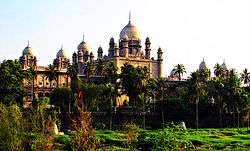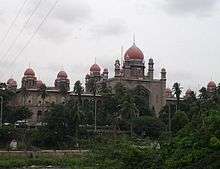High Court of Judicature at Hyderabad
| High Court of Judicature at Hyderabad | |
|---|---|
 High Court Building | |
| Established | 1956 |
| Country | India |
| Location | Hyderabad, Telangana |
| Coordinates | 17°22′09″N 78°28′19″E / 17.369181°N 78.472039°ECoordinates: 17°22′09″N 78°28′19″E / 17.369181°N 78.472039°E |
| Composition method | Executive selection subject to qualification |
| Authorized by | Constitution of India & Andhra Pradesh Reorganization Act, 2014 |
| Decisions are appealed to | Supreme Court of India |
| Judge term length | mandatory retirement by age of 62 |
| No. of positions | 49 |
| Website |
hc |
| Chief Justice of Andhra Pradesh and Telangana | |
| Currently | Hon'ble Justice Thottathil B. Radhakrishnan |
| Since | 7 July 2018 |
The High Court of Judicature at Hyderabad for the States of Andhra Pradesh and Telangana is the common High Court of the Indian states Andhra Pradesh and Telangana. Its chief engineer was Nawab Khan Bahadur Mirza Akbar Baig. High Court of Andhra Pradesh, as it was known earlier, was set up on 5 November 1956 under the State Reorganization Act 1956. The Andhra Pradesh High Court was renamed as High court of Judicature at Hyderabad in view of bifurcation of Andhra Pradesh state. From 2 June 2014, after the Andhra Pradesh Reorganisation Act, 2014 came into force, it has been renamed and serves as a common high court for both the states. A separate high court has to be established for Andhra Pradesh. After a separate High Court for Andhra Pradesh is established, High Court of Judicature at Hyderabad will be the high court solely for Telangana.
The seat of the high court is in Hyderabad and has a sanctioned judge strength of 49.
History of the judiciary
The State of Andhra Pradesh was formed in 1956 by the separation of the merger of the Andhra State which was formed in year 1953 from erstwhile Madras state and the Telangana area of the Hyderabad State which was acceded by Government of India on 17 September 1948 from the Nizam's rule.
History of High Court building

The High Court stands on the south bank of the River Musi. This is one of the finest buildings in the city, built in red and white stones in Saracenic style, by Nizam VII Mir Osman Ali Khan the ruler of the princely state of Hyderabad
The plan of the High Court was drawn up by Shankar Lal of Jaipur and the local engineer who executed the design was Mehar Ali Fazil. The construction started on 15 April 1915 and was completed on 31 March 1919. On 20 April 1920 the High Court building was inaugurated by Nizam VII Mir Osman Ali Khan.
While digging the foundation for the High Court, ruins of the Qutb Shahi Palaces, namely Hina Mahal and Nadi Mahal were unearthed. The High Court looks beautiful and impressive from the Naya Pul Bridge at sunset.
After its construction, a silver model of the High Court with a silver key was presented to the Nizam VII Mir Osman Ali Khan by the Judiciary during the Silver Jubilee Celebrations in 1936. The facsimile of the buildings was perfectly carved in a thick sheet of silver weighing about 300 kg. The model is now in the Nizam's Museum in Purani Haveli.
The main building of the High Court was constructed in the year 1919 by the then Nizam’s Government accommodating Six Judges besides accommodation for the Office Staff, record rooms and Advocates’ Hall.
After the formation of Andhra Pradesh
When the High Court of Andhra Pradesh was formed in 1956 as a consequence of States Reorganisation Act, the Judges strength was increased to 12. The existing accommodation at that time was only inadequate to meet the requirements of the larger High Court and so the additional building was constructed in 1958-59. The entire office rooms, record rooms, chambers of advocates (42 in all) and the rooms for law officers were located in this building. The record rooms, Officer rooms in the main building were modified to provide chambers and Court Hall accommodation for 14 Judges.
Construction of Annexe

By 1970, the institution of cases of the High Court has gone up to 35,000 as against 20,000 in 1958. The Judges strength had also risen from 14 to 21. To provide additional accommodation for Judges, Staff and Advocates and Law Officers, the third building was proposed and the work was completed in 1976. The Law Officers strength was increased from 8 to 18 by 1980 and the institution of cases had gone up to 55,593 cases. In 1979 a plan was drawn for the four-storey Annexe building and due to lack of funds that could not be taken up. There are at present 20 Court Halls and 24 Chambers located in the High Court main building and Annexe buildings. The present building for which the foundation stone is being laid by the Hon’ble the Chief Justice will have 8 Court Halls and 8 Chamber for the Judges. Some of the Court Halls located in the Varandahs and in the office rooms will be restored to their original position. The institution of cases had risen from 20,078 in 1958 to 1982,123 including miscellaneous cases in 1985. Now the pendency of cases in High Court as on 24 July 1987 are 84,855 (i.e., 66,276 main cases + 18,579 miscellaneous cases). The Government of India is contemplating to rise the strength of the Judges of this High Court to 36 and in such case, more funds have to be released for the construction of Annexe buildings. After the completion of this building, the main building and Annexes buildings can locate 24 Court Halls and 26 Chambers.
2009 Major fire
On 31 August 2009 a major accidental fire broke out through the building reportedly causing severe damage to the library housing rare England law reports, Privy Council journals and a life-size portrait of the Nizam and portraits of judges. However, the records of the court are reportedly safe. The structural integrity of the building also may have been compromised.[1][2]
Chief Justices
- Hon'ble The Chief Justice Nawab Alam yar jung Bahadur
- Hon'ble The Chief Justice Koka Subba Rao (1956–1958)
- Hon'ble The Chief Justice P. Chandra Reddy (1958–1964)
- Hon'ble The Chief Justice P. Satyanarayana Raju (1964–1965)
- Hon'ble The Chief Justice Manohar Pershad (1965–1966)
- Hon'ble The Chief Justice N. D. Krishna Rao (1966–1966)
- Hon'ble The Chief Justice P. Jagan Mohan Reddy (1966–1969)
- Hon'ble The Chief Justice N. Kumarayya (1969–1971)
- Hon'ble The Chief Justice K.V.L.Narasimham (1971–1972)
- Hon'ble The Chief Justice Gopal Rao Ekbote (1972–1974)
- Hon'ble The Chief Justice S. Obul Reddi (1974–1976) & (1977–1978)
- Hon'ble The Chief Justice B.J.Divan (1976–1977)
- Hon'ble The Chief Justice Avula Sambasiva Rao (1978–1979)
- Hon'ble The Chief Justice Challa Kondaiah (1979–1980)
- Hon'ble The Chief Justice Alladi Kuppu Swami (1980–1982)
- Hon'ble The Chief Justice Konda Madhava Reddy (1982–1984)
- Hon'ble The Chief Justice Koka Ramachandra Rao (1984–1984)
- Hon'ble The Chief Justice P.Chennakesav Reddi (1985–1985)
- Hon'ble The Chief Justice K.Bhaskaran (1985–1988)
- Hon'ble The Chief Justice Yogeshwar Dayal (1988–1991)
- Hon'ble The Chief Justice S.C.Pratap (1991–1992)
- Hon'ble The Chief Justice S.B.Majumdar (1992–1993)
- Hon'ble The Chief Justice Sundaram Nainar Sundaram (1993–1994)
- Hon'ble The Chief Justice Saiyed Sagir Ahmed (1994–1995)
- Hon'ble The Chief Justice Prabha Shankar Mishra (1995–1997)
- Hon'ble The Chief Justice Umesh Chandra Banerjee (1998)
- Hon'ble The Chief Justice Manmohan Singh Liberhan (1998–2000)
- Hon'ble The Chief Justice Satyabrata Sinha (2000–2001)
- Hon'ble The Chief Justice Dr A.R.Lakshmanan (2001–2002)
- Hon'ble The Chief Justice Devinder Gupta (2003–2005)
- Hon'ble The Chief Justice G.S. Singhvi (2005–2007)
- Hon'ble The Chief Justice Anil Ramesh Dave (2007–2010)
- Hon'ble The Chief Justice Nisar Ahmad Kakru (2010–2011)
- Hon'ble The Chief Justice Madan Lokur (2011–2012)
- Hon'ble The Chief Justice Pinaki Chandra Ghose (2012–2013)
- Hon'ble The Chief Justice Kalyan Jyoti Sengupta (2013–2015 )
- Hon'ble The Chief Justice Dileep Babasaheb Bhosale (2015)
- Hon'ble The Chief Justice Ramesh Ranganathan as acting Chief Justice from 30 July 2016
- Hon'ble The Chief Justice T. B. Radhakrishnan from July 7th, 2018
Current Judges of the Court
Current Chief Justice and Justices of the High Court
- Hon'ble The Chief Justice
- Hon'ble Mr. Justice Ramesh Ranganathan
- Hon'ble Mr Justice V. Ramasubramanian
- Hon'ble Mr Justice C.V.Nagarjuna Reddy
- Hon'ble Mr Justice P.V.Sanjay Kumar
- Hon'ble Mr Justice Suresh Kumar Kait
- Hon'ble Mr Justice C.Praveen Kumar
- Hon'ble Mr Justice M.S.Ramachandra Rao
- Hon'ble Mr Justice Adavalli Rajasheker Reddy
- Hon'ble Mr Justice Ponugoti Naveen Rao
- Hon'ble Mr Justice S.V.Bhatt
- Hon'ble Mr Justice Akula Venkata Sesha Sai
- Hon'ble Mr Justice Challa Kodanda Ram
- Hon'ble Dr Justice Bulusu Siva Sankara Rao
- Hon'ble Mr Justice Mandhata Seetharama Murti
- Hon'ble Mr Justice U.Durga Prasad Rao
- Hon'ble Mr Justice T.Sunil Chowdary
- Hon'ble Mr Justice M.Satyanarayana Murthy
- Hon'ble Mr Justice G.Shyam Prasad
- Hon'ble Ms Justice J.Uma Devi
- Hon'ble Mr Justice N.Balayogi
- Hon'ble Ms Justice T.Rajani
- Hon'ble Dr Justice Shameem Akhter
- Hon'ble Mr Justice Durvasula Venkata Subrahmanya Suryanarayana Somayajulu
- Hon'ble Ms Justice Kongara Vijaya Lakshmi
- Hon'ble Mr Justice Potlapalli Kesava Rao
- Hon'ble Mr Justice M Ganga Rao
- Hon'ble Mr Justice Abhinand Kumar Shavili
- Hon'ble Mr Justice T Amarnath Goud
Registrars of High Court
- Registrar General.
- Registrar (Judicial)
- Registrar (Administration)
- Registrar (Vigilance)
- Registrar (Management)
- Registrar (Protocol)
- District Judge (Enquiries)
- Registrar (Recruitment)
- Central Project Coordinator (IT & E-Committee related)
See also
| This article is part of a series on |
| Government and Politics of Telangana |
|---|
| State of Telangana |
|
Elections
|
|
Local Government
|
References
External links
| Wikimedia Commons has media related to High Court of Judicature at Hyderabad. |
- Official website
- http://causelists.nic.in/apnew/index1.html
- http://judis.nic.in/judis_andhra/chejudis.aspx